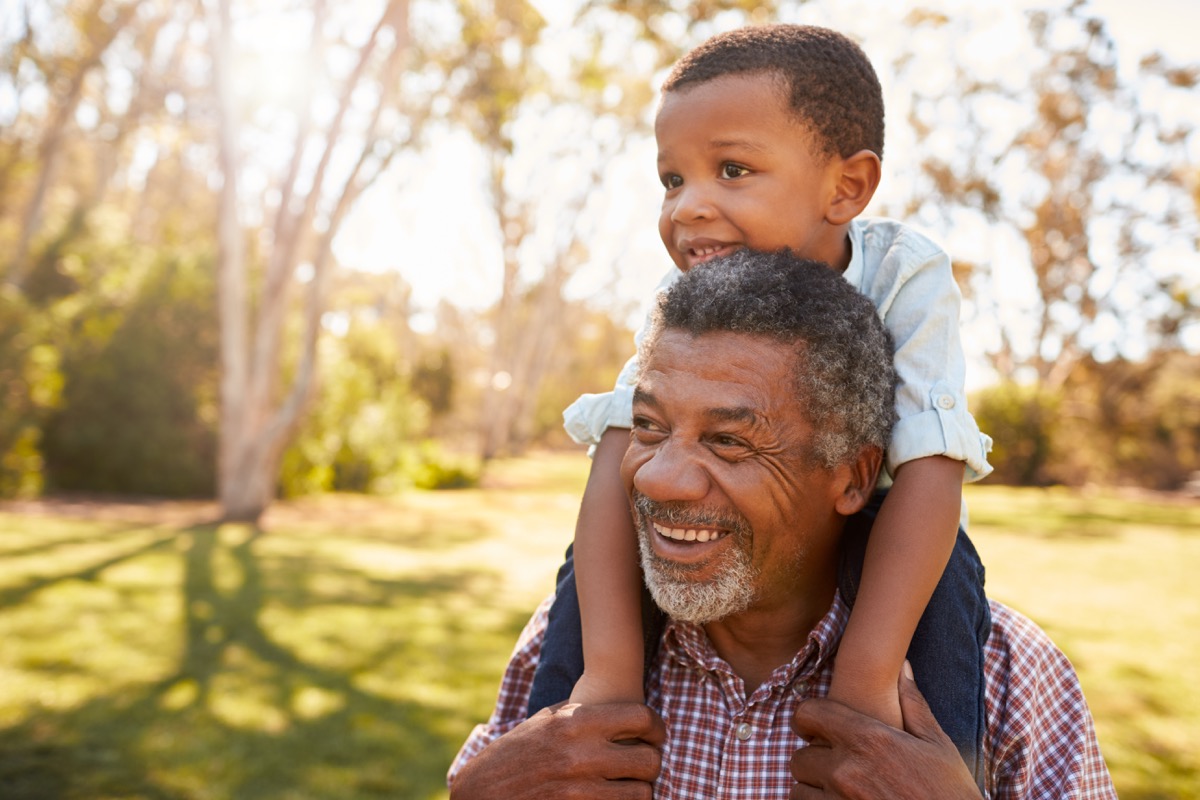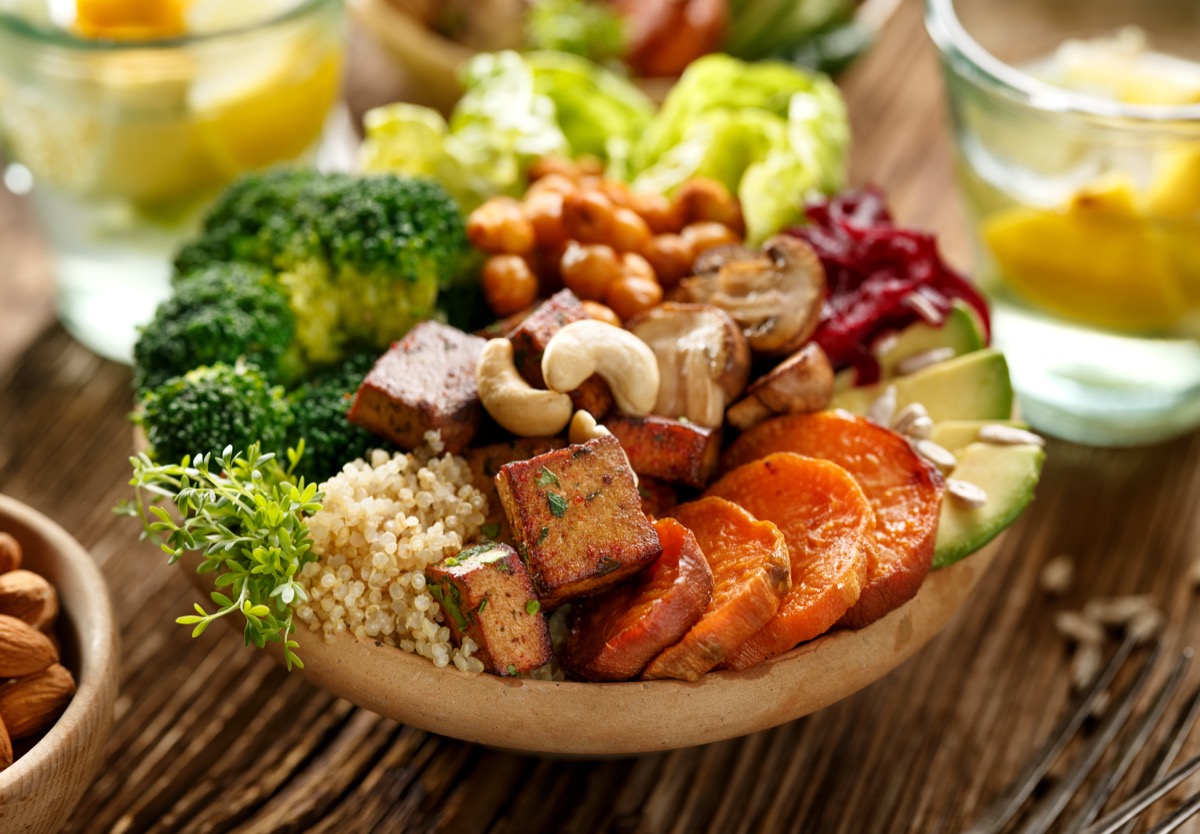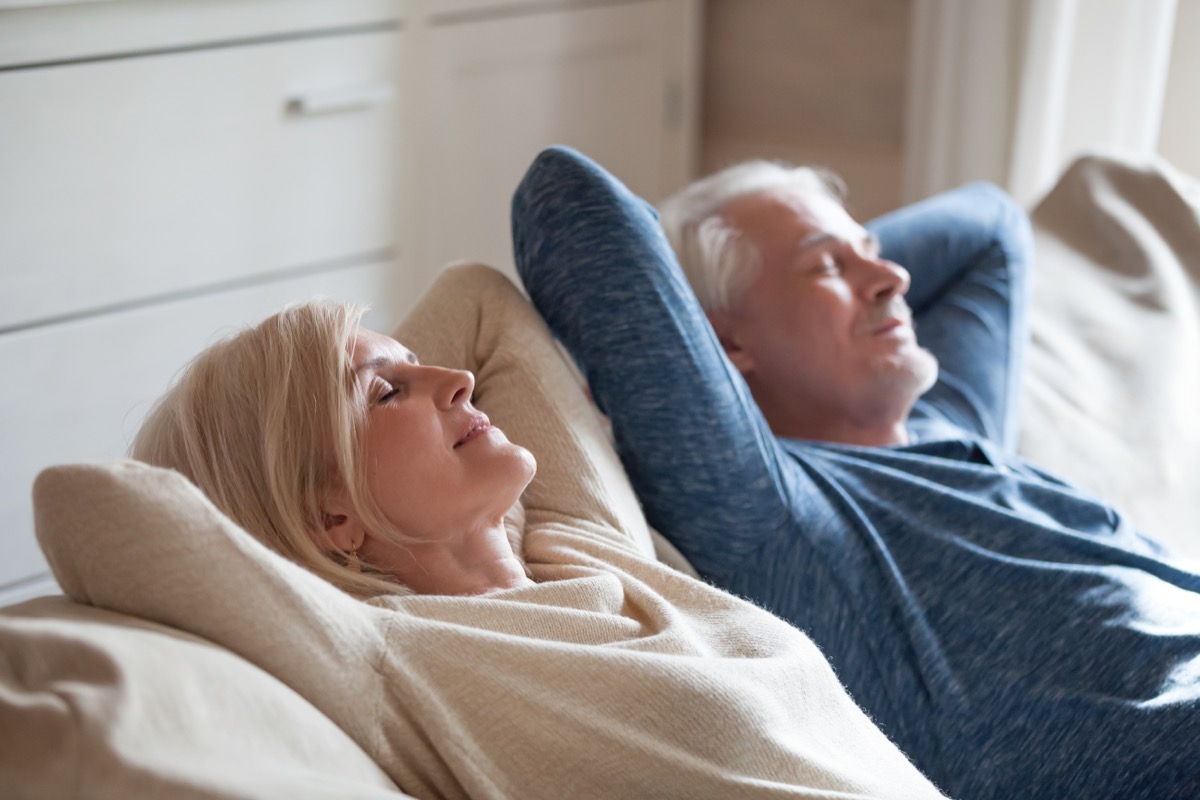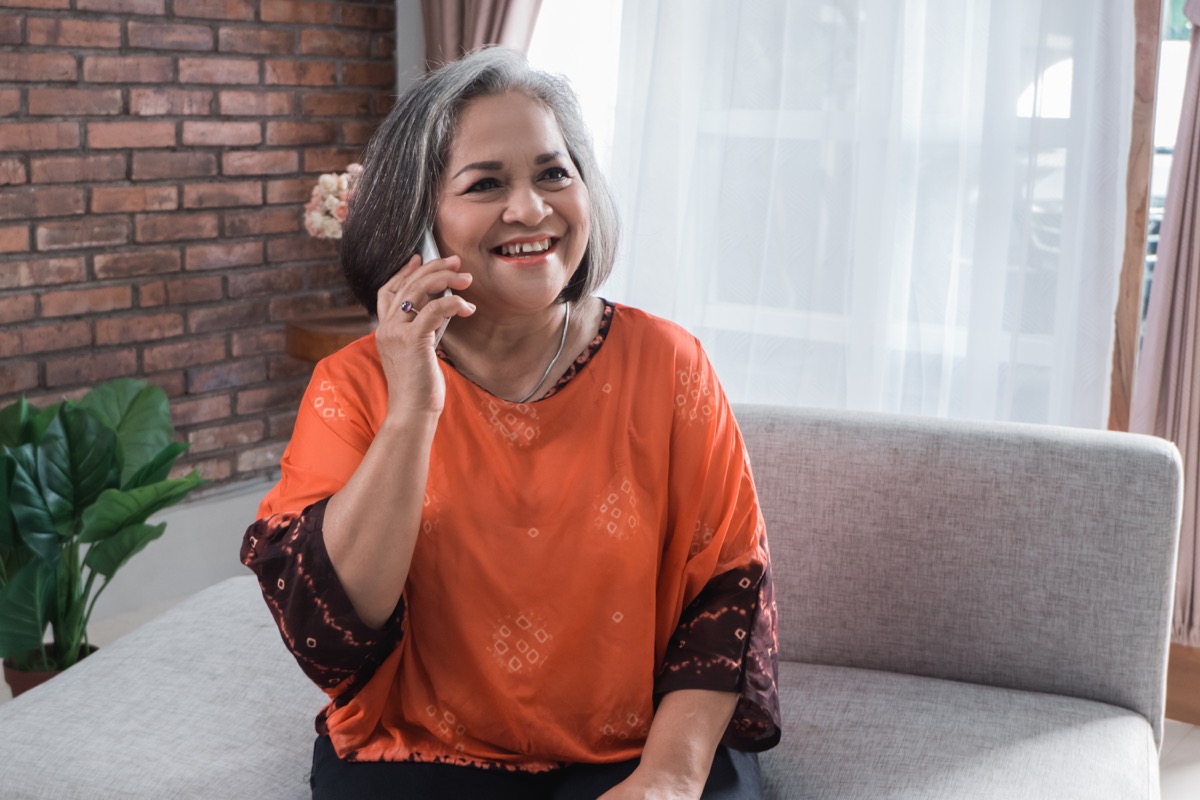50 Easy Ways to Stay Fit After 50

It’s never too late to start focusing on yourself. In fact, your 50s are the perfect time to prioritize your fitness. Because now that you’re older, working out isn’t just about looking better—it’s about feeling better and being able to maintain your mobility and health for decades to come. Herein, we’ve rounded up 50 expert-approved everyday changes that will get—and keep—you fit now and in the future.
1
Rethink your idea of exercise.

Trying to stay fit after 50 can be intimidating if your idea of exercise is only those heart-pounding, high-energy workouts. However, according to Harvard Medical School, there are many different activities that count as exercise that you’re likely to find far less overwhelming. Things like gardening, moderate housework—like sweeping and vacuuming—and even dancing, for example.
“Ballet is great for strength and flexibility,” sports health physician Kim Gladden, MD, told the Cleveland Clinic. “Jazz, swing, and contra dancing will give you cardio benefits. And if you’re looking to do something with your partner, ballroom dancing is fantastic.”
2
Go to group fitness classes.

One of the best ways to encourage yourself to work out is to sign up for a group fitness class. “Groups can be really motivating thanks to the social component,” says Debra Atkinson, a certified strength and conditioning specialist and the founder of Flipping 50. “Especially if people begin to recognize when you’re not there and miss you.”
Many studios even offer free or discounted trial periods, making it easy to figure out where you feel most comfortable and which types of workouts you enjoy. After you start attending classes regularly, you’ll get into a routine—and maybe even make some new friends along the way.
3
Eat more plant-based meals.

Staying fit means filling your body with wholesome foods that improve your health and well-being—and evidence suggests that plant-based sources might be best.
“Research over many years has linked plant-based diets to lower rates of heart disease, type 2 diabetes, and some cancers, as compared with diets high in meat and other animal products,” Robert H. Shmerling, MD, a rheumatologist in Boston, Massachusetts, told Harvard Health.
In fact, one 2019 study published in the Journal of the American College of Cardiology found that sticking to a plant-based diet can decrease your risk of heart failure by more than 40 percent. What’s more, a 2019 study published in The Journal of Nutrition found vegans tend to be healthier than those who follow other diets.
4
Chat with your doctor about your fitness.

Regular doctors appointments benefit your health during every stage of your life, but it’s especially important to keep up with them in your 50s. “Be sure to talk about heart health and exercise with your doctor,” says Michael James, a trainer at the boxing gym EverybodyFights. “They’ll let you know exactly what you can and cannot do based on your current health and any medications you may be on.”
5
Track your steps.

Another easy thing you can do to stay fit is to monitor your steps using a fitness tracker—making sure to meet a specific goal on a daily basis.
“Park further away from the store, take your dog out, or go out on a walk with friends,” suggests Holly Roser, a celebrity trainer and certified sports nutritionist in San Mateo, California. “The more you move, the more energy you’ll have—and it will help you burn more calories overall.”
According to a 2008 study published in the Journal of Physical Activity and Health, women over 50 should aim for 10,000 steps a day, while men should shoot for 11,000 in order to control their weight and improve their health.
6
Cut back on salt.

We know it’s hard to resist your favorite super-salty snacks, but it’s in your best interest to practice self-control when it comes to your salt intake.
“Consuming too much sodium may lead to high blood pressure and can also cause inflammation in the body,” says Amy Gorin, a registered dietitian nutritionist in the New York City area who recommends aiming for no more than 2,300 milligrams of sodium daily. And if you have high blood pressure or pre-hypertension, limit your daily intake to 1,500 milligrams daily, she says.
To help you stick to those numbers, Gorin recommends swapping your salt shaker for sodium-free seasoning. “After all, 11 percent of the typical person’s sodium intake comes from the salt shaker,” she says.
7
Don’t forget to warm up.

A good warm-up is just as important as your actual workout. “It helps you burn more energy during exercise, increases your circulation, and delivers oxygen to working muscles,” Atkinson says. “And it increases your body’s core temperature, allowing the muscles and joints to slowly adapt to greater demands, which reduces your risk of injury.” It can be as simple as walking on the treadmill, doing some jumping jacks, or going on a quick jog around the block—whatever helps your body loosen up and prepare for exercise.
8
Don’t limit yourself to cardio.

While it’s certainly important, cardio-centric exercises are not the only way to stay fit—not by a long shot. “A majority of my clients who are in their 50s believed that cardio was the only thing they needed to be doing to stay in shape or improve their health,” James says. “It wasn’t until we added strength training that they truly started to see and feel the benefits of the time they spent in the gym.”
According to James, resistance training can help improve your balance, control blood sugar, build bone density, increase your metabolism, and even prevent sarcopenia, which is age-related muscle loss.
9
Drink enough water.

Think of water as your body’s fuel. If you’re not getting enough, how is it supposed to run correctly?
“Your body is about 60 percent water and needs to be continually hydrated throughout the day,” Gorin says. “A good baseline amount is 15.5 cups daily for men and 11.5 cups daily for women, but this amount could change if you’re exercising or sweating a lot.”
According to the Mayo Clinic, getting enough fluids helps your body control temperature, protect sensitive tissues, lubricate and cushion your joints, and aid in digestion—all things you might need extra help with as you enter your 50s and beyond.
10
Always focus on form.

Even when you’re making sure to get the right amount of regular exercise, you’re not going to do yourself any good without prioritizing the use of proper form.
“When you’re over 50, your joints and ligaments are a little less forgiving and resilient than they once were,” Atkinson says. Because of that, if you don’t perform exercises correctly, you could be putting yourself at risk of injury that’s only going to slow you down. If that means ditching heavy dumbbells for lighter ones so you can perform the movements correctly, that’s what needs to be done. You’ll build and tone your muscles and be safer in the process.
11
Start an exercise program.

If you don’t already have a solid workout routine, it might be a good idea to kick things off with a structured exercise program—something that will give you a plan of action and an outline to follow. That way, you’ll stay motivated and have something to push you. By the time the program is over, exercise will have become a habit. There are plenty of different online options you can choose from based on your workout of choice, whether that’s bodyweight training, dance, yoga, or something else.
12
Keep a food journal.

As you get older, your stomach can’t always handle what it once could in your younger years. That’s why it’s important to keep track of what you’re eating, Gorin says. “In addition to logging what you eat, you can also write down how different things affect your body and any associated symptoms.” It’s a great way to help you reach your weight goals, too.
13
Ask yourself “why?”

Before you begin your journey of staying fit, be sure to ask yourself why you are doing this. Maybe it’s to make sure you’e around long enough to see your grandkids grow up, or maybe it’s to be healthy enough to travel the world once you retire. Whatever the case may be, having a reason behind what you’re doing will help you stick with that commitment and keep it a top priority in your life.
14
Don’t push yourself too hard.

Instead of jumping into an intense routine full-force, start slow and ease your way into an exercise program that works for you. Then once you get going, there’s nothing you can’t achieve. “Someone over 50 can do the same moves as a 25-year-old,” Roser says. “There’s really no contraindication of age and working out.”
15
And don’t be afraid to make changes.

It can be hard to switch things up once you get into a routine, but if it’s not helping you reach your goals or you’re not enjoying it, making the right adjustments could be the key to finding what’s best for you and your body.
“There are several ways you can spice up your current workout routine, including boosting the intensity of your workouts,” Jessica Matthews, a wellness coach and assistant professor at Point Loma Nazarene University in San Diego, told ACE Fitness. “You can also cross train and perform different activities to provide your body with a new challenge.”
16
Utilize online workout videos.

There’s an endless amount of workout videos and apps that allow you to exercise right in the comfort of your own home, including high-intensity training sessions, Pilates, and mood-boosting Zumba classes. Even starting with something simple, like a beginner yoga flow, is beneficial. “While you may think the less difficult moves don’t do anything, those are the most important exercises to learn as they will be the first to develop your posture, strength, and increase flexibility,” Roser says.
17
Focus on low-impact exercise.

When you’re in your 50s, you don’t want to do anything that’s going to cause injuries or pain. That’s why James is a big fan of low-impact exercises like cycling, Pilates, and Tai chi. And according to Harvard Medical School, low-impact activities are a great way to ease into an exercise routine—especially if you haven’t previously been keeping up with one.
18
Become a yogi.

Aside from yoga being a gentle way to improve your physical fitness, Harvard Medical School says it can also improve your sleep, help you lose weight, and boost your mood. “Even if you’re new to yoga, there are so many different levels and difficulties you can choose from, which allows you to build upon your skillset and develop at your own pace,” Roser says.
19
Try Pilates.

Despite being a challenging workout, Pilates is another great low-impact option that’s gentle enough to help you recover from injuries—as well as prevent them. “Pilates strengthens the core and lower body, increasing balance and overall strength, which is extremely important to maintain as we get older,” Roser says. “We lose three to five percent of muscle mass per decade after 30, so it’s important to keep strength training as much as possible.”
20
Make fitness fun.

If you hate your workouts, you’re not going to stick with them. That’s why Kelli Fierras, head trainer at EverybodyFights, says your number one mission should be finding something you really enjoy doing. Your friends might love running or lifting weights, but if that’s not you, switch things up. When you discover something that boosts your endorphins and makes you feel happy, you’ll look forward to exercising, not dread it, she says.
21
Go for a dip.

One of the most beneficial workouts you can do in your 50s is swimming—which works your entire body and protects your joints from stress and strain, the Cleveland Clinic says. “It helps people build their aerobic and cardiovascular base, and it can build your muscle base up without hurting your joints,” Charles Klettner, MD, an internal medicine physician in Michigan, told Grand Traverse County Parks and Recreation.
22
Get a workout planner.

It might feel silly having a separate planner just for your workouts, but it could be the key to staying in good shape throughout your life. “It’s a simple way to increase your exercise success,” Atkinson says. “It doesn’t take more than a few minutes to plan your week and jot down notes about how you felt after exercise, how you slept, and any soreness the day after.” By tracking everything, you can look back and see what’s working and what’s not in your fitness routine.
23
Walk as much as you can.

Don’t like running, but want to get some fresh air while also working on your fitness? “Power walking or walking uphill is a great form of exercise for older adults as it’s low impact, easy on the joints, has a low risk of injury, and is cost-effective,” Roser says. “It’s something anyone can do just about anywhere, and it’s been proven to decrease the risk of heart disease, lower blood pressure, boost your immune system, and reduce arthritis pain.”
24
Connect with nature.

Whether it’s going on a walk around your neighborhood or hiking some trails in the woods, the important thing is finding a way to be active outside—doing so provides a wide range of benefits for both your physical and mental health, a 2013 study published in the journal Extreme Physiology & Medicine found.
“Research suggests when people are active in nature, they have a dramatic shift in mood and outlook,” Kelly McGonigal, PhD, a health psychologist, told The Awake Network. “Exercising outdoors is incredible medicine for the many people who suffer from depression, anxiety, trauma, or grief.”
25
Use a vibration plate.

If you haven’t utilized the vibration plate at your local gym yet, you’ll want to start now. According to the Mayo Clinic, this workout-enhancing machine transmits energy to your body as it vibrates, which in turn makes your muscles contract and relax multiple times per second. As little as 15 minutes of body-weight exercises on the plate a day can provide serious benefits.
The vibration plate “has been shown to increase bone and muscular development in older people,” says Neil Paulvin, DO, an integrated medicine physician in New York City. In addition, it could also help with weight loss, burning fat, and improving flexibility.
26
Do weight-bearing exercises.

You don’t have to go crazy with the weights to work your muscles. All you really need is a pair of small dumbbells and a little dedication. “Engage in weight-bearing exercise at least three times per week,” says Paulvin. “This can simply be using some light weights to help maintain muscle and bone.”
27
Try Tai chi.

Tai chi is one of the gentlest forms of exercise you can do, making it a top choice for all ages and fitness levels. The flowing movements don’t just help better your body physically by increasing your muscle strength, flexibility, and balance—they also improve your overall health. “There are a number of studies that have suggested that the practice of Tai chi exercises can reduce blood pressure, reduce falls, and reduce resting heart rate,” rheumatologist Mary Jurisson, MD, told the Mayo Clinic. “It also might be helpful in people with back pain and osteoarthritis.”
28
Improve your gut health.

Now that you’re in your 50s, the muscles and nerves in your digestive tract might not function as well as they used to, leading to issues like constipation and diarrhea. To keep feeling your best, start giving your gut what it needs to thrive: probiotic supplements or fermented foods.
“Eating foods like certain yogurts and unpasteurized sauerkraut can help your digestive health,” Gorin says. “Probiotics may also be helpful for weight loss.”
29
Stretch your muscles regularly.

Stretching is never at the top of anyone’s list of priorities, but it’s just as important as working out. “As we age, our flexibility decreases and tight or short muscles make you susceptible to injury and pain—especially with your knees and lower back—so take the time to stretch after any workout,” James says. “Any basic static stretch—like a hamstring stretch, for example—should last about 30 seconds.”
30
Work out with a friend.

There’s no better motivation than having a fitness friend who keeps you accountable. “Don’t make exercise a chore. Find a buddy to make it more enjoyable,” Fierras says. Maybe it’s someone you met in one of your group fitness classes, a co-worker, or family friend. Whomever it may be, regularly schedule in walks, yoga sessions, or whatever you both enjoy. It’s the ultimate double-whammy—time with someone you enjoy being around and getting your sweat on.
31
Get your protein fix.

Since you naturally lose muscle as you age, getting adequate protein through nutrition is crucial to your health and well-being. “Women, for instance, lose about 10 percent of muscle mass each decade after age 45,” Gorin says. “Muscle is important for strength and ease of doing daily activities. It’s also important to prioritize exercise and do resistance training, as this can help counteract the decline in metabolism that occurs with aging.” Choose heart-healthy options like lentils, nuts, quinoa, wild rice, tempeh, and tofu.
32
Do a weight-loss challenge.

If one of your primary reasons for becoming fit in your 50s is losing weight, Fierras recommends doing a weight-loss challenge so you have something to strive for. There are even ways you can make it more fun, like using DietBet, which lets you win money when you shed pounds. It works, too: In a 2008 study published in JAMA, those who could win or lose money simply for losing weight had better results, losing significantly more weight than those who didn’t have an incentive. You can also put your goal weight on a dry-erase board and cross off the pounds until you hit it.
33
Allow time for recovery.

To make sure you’re ready for your workouts, take the time to recover—even if you don’t feel like you need to. “Recovery is extremely important after exercise—especially for those 50 and up, as this is a time for your blood pressure to come back down to normal,” Roser says. It’s also a time to take full advantage of all the healthy changes that occur in your body post-workout, says the Mayo Clinic. That means staying hydrated, skipping alcohol, adding carbs and protein to your meals, and getting enough sleep so you can heal and feel your best.
34
Focus on your sleep.

You might experience more sleep problems as you age—like insomnia or snoring, says the National Sleep Foundation—but getting quality rest is so crucial to your health and staying fit. According to Michael Breus, PhD, a clinical psychologist and sleep expert in Los Angeles, California, when you get poor sleep, health issues can follow, including obesity, diabetes, and heart disease.
“Your body has a much tougher time fighting back against disease and illness when it’s sleep deprived,” Breus wrote on his blog.
35
Balance heavy workouts with light ones.

Another part of the recovery process is making sure you’re balancing intense, sweat-dripping workouts with lighter ones. Instead of constantly doing high-energy workouts that leave you exhausted and sore, it’s best to add some low-impact workouts—like light yoga, a jog, or stretching-based sessions—into your routine as well.
“Balancing hard and easy days is important at every age; we’ll all age more optimally and have a higher fitness level if we do so,” Atkinson says. “Exercise provides the opportunity for fitness, and the fitness happens in the recovery between exercise. It’s those days of light movement when you’re just increasing oxygen to working muscles that you’re optimizing your fitness. Some exercise requires recovery and some exercise is recovery.”
36
Find a personal trainer.

If you think you’d do better being guided through your workouts by an expert, try a personal trainer. “It helps you see where your muscle imbalances are and how to correct them,” Fierras says. It also ensures you’re doing every exercise correctly and developing good form that can strengthen your body.
37
Work on your posture.

If you’ve been slacking on good posture over the years, now’s the time to start paying more attention to your body alignment. “When your alignment is off, it has an impact on your whole body,” Elizabeth Frates, MD, a physiatrist and professor at Harvard University, told Harvard Health. “Think of it as a chain reaction: poor posture pulls other parts of your body out of line, leading to muscle pain and other problems.”
According to the Mayo Clinic, standing up straight helps fight off pain by preventing strain on your joints, muscles, and spine. It can also boost your mood, decrease your risk of injury, and help better your workouts and your ability to strengthen your muscles.
38
Start resistance training.

If you haven’t added resistance training into your routine—which involves working against your own body weight or using dumbbells and exercise machines—start now. “It will help with balance, muscle loss, and your overall health,” Fierras says. Even starting small with a couple of sessions a week will make you feel a difference.
39
And make sure that includes resistance bands.

While small dumbbells are a great way to stay fit, Paulvin also recommends doing resistance band-based workouts. “They can help you maintain muscle and bone,” he says. It’s a gentle way to work every muscle group in your body—especially because the bands come in different strengths, based on your current fitness level. And when you travel, they’re easy to pack and take along on your trips.
40
Take in some vitamin D.

Vitamin D plays a big role in your health, particularly with your bones. “Vitamin D helps your body absorb calcium, and not having enough vitamin D may make your bones more likely to break,” Gorin says. “Those 50 and older should strive to take in 800 to 1,000 IU per day.” Since the sun is such a great source, Harvard Medical School says getting 10 to 15 minutes of sunlight on your arms and legs a few times a week can also help keep you healthy.
41
Make time for meditation.

When it comes to staying fit in your 50s, taking care of your mind is just as important as taking care of your body—and doing so can result in major benefits for both. Preventive medicine physician Roxanne Sukol, MD, told the Cleveland Clinic that meditation has long-term benefits for certain organs—particularly the brain, as it improves blood circulation there, as well as other areas of the body. You don’t need to devote a lot of time, either. “When I first started, I used a one-minute mindfulness meditation. Breathe in for five seconds, then breathe out for five seconds. That’s your warm-up. Then repeat for one minute. It’s that simple, and you can work up from there,” Sukol says.
42
Don’t do anything that hurts.

While some exercises will feel great, others might not. “If what you’re doing hurts, stop immediately,” James says. And that applies even if you’re in a class surrounded by other people. Instead of sticking with something painful just because you feel like you have to, always go with the exercises that make your body feel good. Otherwise, that could result in an injury that sets you back from reaching your goals.
43
Improve your mobility.

Speaking of injuries, one way Fierras recommends staying ahead of them is working on improving your mobility—meaning your ability to move freely and easily. “This will not only help your flexibility but also your neurological strength to do a movement correctly, which creates a strong body,” she says. There are plenty of different ways you can do so, like through hip openers and neck half circles. It all depends on which areas you need to work on.
44
Limit your alcohol intake.

You might like having a drink every now and then, but don’t make it a regular occurrence. As you get older, your body’s tolerance for alcohol lowers. According to the National Institute of Health, that makes you feel its effects more quickly and puts you at a greater risk for accidents and injuries. Drinking can also cause increased health problems. Cardiologist Sheldon G. Sheps, MD, told the Mayo Clinic drinking too much can raise your blood pressure to unhealthy levels. And because of the calories it contains, it can also cause unwanted weight gain.
45
Zone in on your back muscles.

As you age, it’s important to keep your back strong. “The cumulative effect of a life of moving forward and doing everything in front of us will cause a rounding of the spine and add unnecessary stress,” Atkinson says. “Luckily, you can easily avoid that by strengthening the back.”
The Mayo Clinic recommends dedicating 15 minutes a day to a handful of exercises that can help prevent any issues from occurring in your back, including knee-to-chest stretches, bridges, and the cat stretch.
46
Focus on the small things.

Don’t just focus on reaching those huge goals in your fitness journey. “No matter whether it’s doing a 5K or doing 10 push-ups with no rest, give yourself something to work toward,” James says. These accomplishments might feel tiny in the moment, but they’re bettering your health in a big way.
47
Make a good playlist.

If you want to make every workout fly by—and enjoy every second you’re sweating it out—Fierras recommends focusing on your playlist. “Always listen to your favorite music while working out,” she says. It makes a huge difference in your mood, and when you’re feeling happy and positive, your workouts will go better, too.
48
Try cold laser therapy.

If you find that it takes you quite a while to recover from exercise, one thing that might help is using cold laser therapy, which, Berkeley Wellness says, uses low-level light energy to help with aches and pains.
“People who exercise or continue to play sports in their 50s can maintain strength and stamina. The challenge is that it takes much longer for their bodies to recover,” says Marsha Dirks Prada, DC, a chiropractic specialist and co-owner of Denver Sports Recovery. “Whole-body cold laser therapy, such as Prism Light Pod, can help accelerate recovery four to 10 times faster.”
49
Try red light therapy.

Red light therapy is known for helping with everything from clearer skin to improved hair growth. One thing people don’t realize is that it’s also great for staying fit in your older years. “Red light therapy has been shown to stimulate bone growth, increase testosterone in men, and help maintain your thyroid,” says Paulvin. “This should be done three to five times per week.”
50
Don’t be afraid to ask questions.

Staying fit can be intimidating—especially since there are so many types of workouts and exercises to choose from. That’s why James says you should never be afraid to call for back-up. “Find a fitness professional you trust,” he says. “Trainers that specialize in corrective exercise and functional movement typically will have a lot of experience with 50-or-older clientele.”